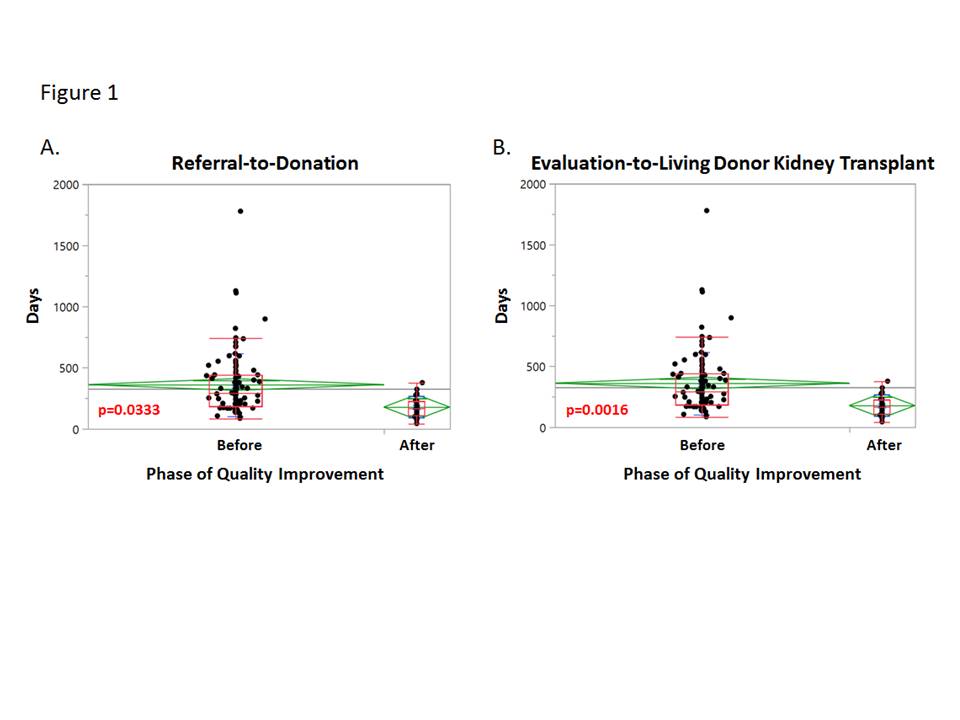Using Quality Metrics to Improve Access to Living Donor Kidney Transplantation
Mayo Clinic, Phoenix, AZ
Meeting: 2020 American Transplant Congress
Abstract number: B-213
Keywords: Kidney transplantation, Living donor, Quality of life
Session Information
Session Name: Poster Session B: Quality Assurance Process Improvement & Regulatory Issues
Session Type: Poster Session
Date: Saturday, May 30, 2020
Session Time: 3:15pm-4:00pm
 Presentation Time: 3:30pm-4:00pm
Presentation Time: 3:30pm-4:00pm
Location: Virtual
*Purpose: Living donor kidney transplants (LDKT) are an excellent option for patients with kidney disease. Delays in donor evaluations can impact donor satisfaction as well as recipient waitlist times and quality of life. Reducing these delays can potentially increase the number of LDKT performed and improve the quality of life for transplant patients. The aim of this study was to use process improvement methods to reduce the evaluation-to-transplant times for both living donors and recipients.
*Methods: Define, Measure, Analyze, Improve, Control (DMAIC) improvement methodology was applied to the Mayo Clinic Arizona LDKT program in January 2018. Reported results reflect June 1, 2018 to present. High process maps were used in the define, measure and analyze phases. Brainstorming, an affinity diagram, and idea prioritization tools were used to vet true root causes and prioritize opportunities for improvements.
*Results: By using the DMAIC process, several major improvements were accomplished including optimization of donor intake, improvement in communication strategies with patients, reduction in the evaluation period, elimination of pre-evaluation HLA and ABO testing, and implementation of a Living Donor Champion Program. After these improvements, the median time of living donor referral-to-donation was reduced from 163 days (n=94) to 140.5 days (n=46) (p=0.033) (Figure 1A). Recipient evaluation-to-living donor transplant times were reduced from 289 days (n=94) to 167 days (n=21) (p=0.002) (Figure 1B). Patient satisfaction was maintained at 79% during this process (p=0.951). With these changes we observed a 1.6 fold increase in LDKT volumes in 2018 (Figure 2).
*Conclusions: Using a quality improvement process, we were able to reduce median living donor referral-to-donation variation time by 22.5 days and recipient evaluation-to-living donor transplant time by 122 days. This effort demonstrates that transplant volumes can be managed as standardized workflows. By making seemingly simple changes, the quality improvement process allowed us to better optimize our workflow thus allowing donors and recipients to complete their evaluations faster and ultimately allow for increased LDKT opportunities.
To cite this abstract in AMA style:
Jadlowiec C, Petrosky M, Welch J, Holligan S, Thorp A, Wilson S, Mansour C, Mathur A, Reddy K, Khamash H, Engholdt K. Using Quality Metrics to Improve Access to Living Donor Kidney Transplantation [abstract]. Am J Transplant. 2020; 20 (suppl 3). https://atcmeetingabstracts.com/abstract/using-quality-metrics-to-improve-access-to-living-donor-kidney-transplantation/. Accessed November 9, 2025.« Back to 2020 American Transplant Congress


